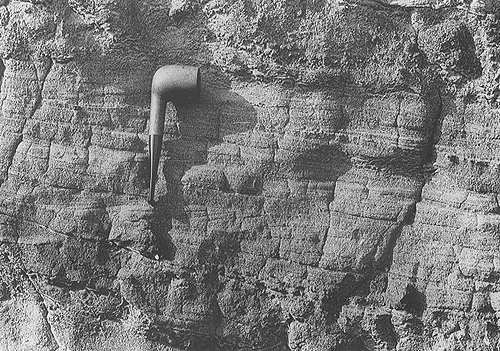
Small-scale hummocky cross-lamination
Plate 48

Small-scale hummocky cross-lamination
Plate 48
Sets of low-angle convex laminae are here truncated by slightly curved surfaces. The thickest laminaset (below the pipe) shows a preferential dip to the left, which suggests a certain amount of lateral accretion of a hummocky bed form. In cases like this, one can invoke a unidirectional component of movement, i.e., a current. Actually, storms are stimulated by strong winds, and these winds can produce not only waves on the water surface, but also currents down to a certain depth. Such currents sometimes have a tractive capacity; that is why many sedimentologists think that hummocky cross-bedding derives from a combination of wave and current action.
This is the same outcrop as in plate 45 B (Quaternary volcaniclastics reworked in the littoral zone); we see, then, that hummocky forms and normal ripples are associated in this unit. Hummocks formed during storm conditions, ripples during fair weather, when normal waves reworked the storm deposits.
Having previously defined the concept of wave base, I must now specify that there are at least two such levels: one for normal waves and one for storm waves, the latter being obviously deeper. Whereas ripples can form only above the fair weather wave base, hummocks form both above and below it. Shallower hummocks are canceled, but deeper ones escape destruction and are preserved under mud drapes.
Other examples of small-scale hummocky cross-lamination are illustrated in color photo 5, from Pliocene sandstones of northern Apennines. Storm beds are found in submarine beaches exposed to the open sea, in shelves, and in protected water bodies (bays, lagoons, large lakes). When storms invade tranquil environments, their deposits and related structures are more easily preserved thanks to the absence of mechanical reworking during normal conditions.
Hummocky and swaley cross-bedding, in conclusion, are structures indicative of traction and deposition under storm conditions. As such, their presence indicates a storm layer, or tempestite. Not all tempestite beds, however, contain hummocky or swaley cross-stratification. Pay attention to this type of logical connection, which is frequent in geology: feature A implies process B, but B implies either A or other characters, depending on circumstances. In other terms, there is no biunivocal link between cause and effect. This must be clear for a correct understanding and use of the features that are qualified as indicators.